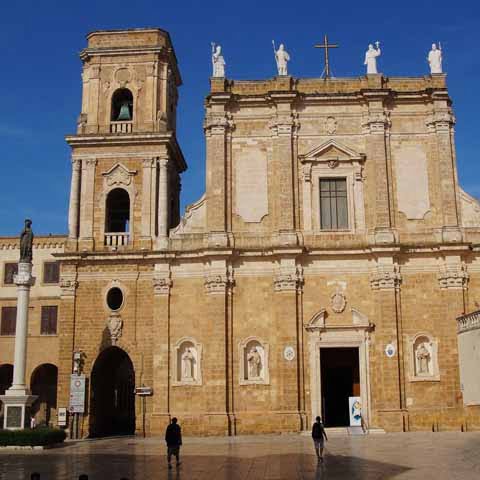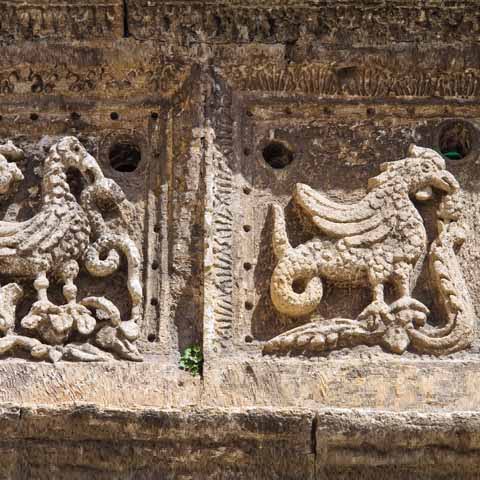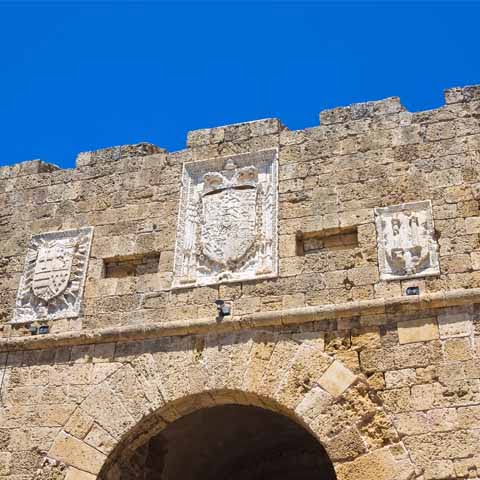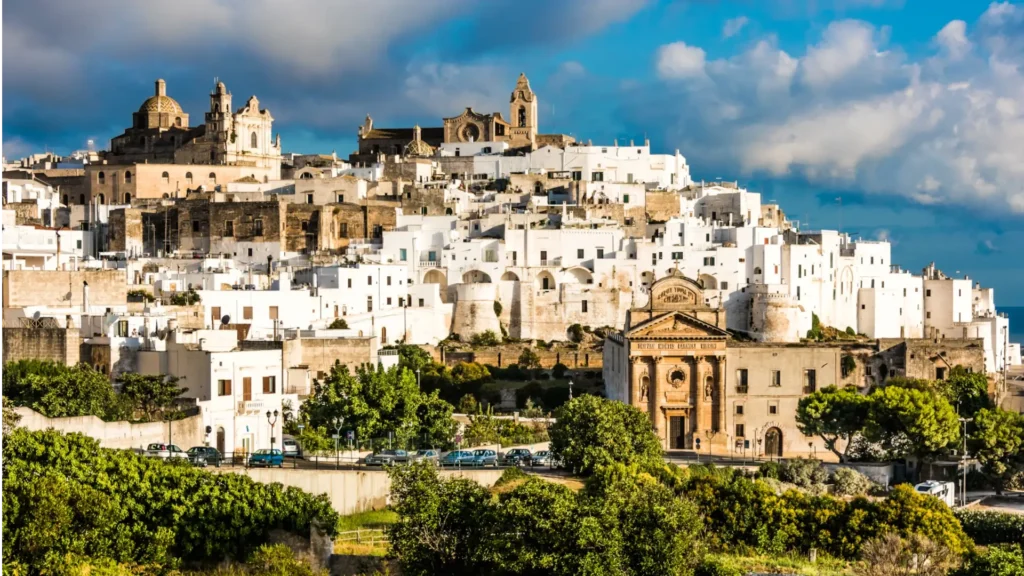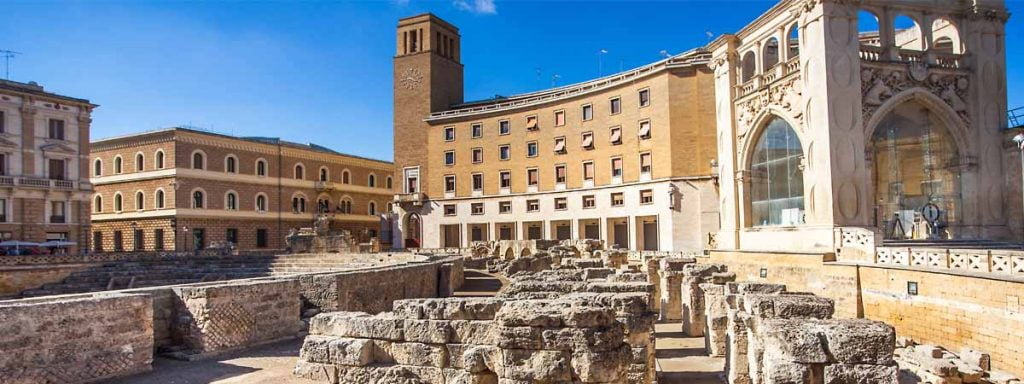Brindisi is a beautiful city located on a small headland on Apulia’s coast, along a creek that branches off into the Adriatic Sea. The Pigonati Canal and the two branches of the creek form a natural inland port, the only one of its kind on the Adriatic coast of Apulia.
The canal opens up to the outer harbor, protected by the island of Sant’Andrea and followed by an outpost delimited by the Pedagane islets.
The history of the city is strongly connected to its geographical position with the port that has always been a natural gateway to the East.
The original nucleus, surrounded by megalithic walls, was located on the highest and most extreme point of the peninsula, in correspondence to the area surrounding the current Piazza del Duomo. But the city only gained its importance after the Roman conquest.
Linked to Rome by Via Appia, Brindisi became the main Roman port to the East, playing a leading role both as a commercial center and as a military base. This led to a true expansion of the original settlement and to a prolific growth of the population.
The urban agglomeration shows a rather compact appearance. The Old City was developed above the original Messapian center on the peninsular ledge that stretches between the two arms of the port. Despite having undergone significant changes due to damage and restorations throughout the centuries, Brindisi still preserves the fascination of the original urban layout and considerable remains of the sixteenth-century walls.
The modern development of the city began in 1865 with the inauguration of the railway station, and in 1927, when Brindisi became the provincial capital, the city started to expand beyond the city walls.
An extraordinary demographic and topographical expansion took place after 1950 when the industrialization processes involved the port area. In the 1960s the Paradiso district emerged, which was a residential area of the middle bourgeoisie, while the popular Perrino district developed on the shores of Seno di Levante. Today, the city is an important cultural center for Apulia’s Salento Peninsula.
PREHISTORY OF BRINDISI
The territory of Brindisi has been inhabited since the earliest times. It is believed that the first civilizations to have settled on the shores of the Adriatic had Cretan-Mycenaean origins but merged with the Illyrians into a single population, that of the Iapygians-Messapians.
According to evidence left by various pre-Roman inscriptions, Brindisi was an important trade center and the capital of Messapia, perhaps because of its strategic position on the sea. Always competing with neighboring Taranto, Messapian Brindisi enjoyed intense trade and exchange relations with the East, above all with the Aegean populations.
But for Magna Graecia, peaceful trade was not enough. At the time, Taranto was one of the most important Greek cities in the peninsula, representing the Spartan and Hellenic cultures, and Magna Graecia was seeking to extend its influence over nearby territories.
This marked the beginning of frightful wars between the Greeks and the Messapian League that culminated with the definitive defeat of the Greeks in 475 BC. But the peace achieved by the cities of Salento, Brindisi included, only lasted for about two centuries, until the Romans started to manifest their interest in the region.
Rome conquered Brindisi in 267 BC, interested in the strategic importance of the city. In fact, the Romans saw Brindisi as a true gateway for expansion towards the Balkans and Greece.
HISTORY OF BRINDISI
The Roman period was one of the most fruitful for Brindisi. Roman legions colonized the city, which was granted the statute of municipality in 83 BC. Due to its strategic importance, the settlement enjoyed a strong development of public buildings and infrastructure, as Rome had all the interest to create a direct route between the Capital and the city through Via Appia and Via Traiana.
Soon after, the city became an important naval station for the embarking and disembarking of the legions in their efforts to conquer Macedonia, Asia, and Greece. The municipality also played an important role during the civil wars between the Caesars contending for the dominion of the Roman Republic.
The Peace of Brindisi was concluded between Octavian and Antonius, a peace that marked the end of the Republic of Rome, with Octavian being hailed as the first Emperor of Rome after the death of Caesar.
The importance of Brindisi during Roman times is attested by Cicero in his famous Lettere Brindisine, while Horace also mentions the city in various poems.
During this age, the city was embellished with numerous temples, public baths, an amphitheater, an academy, and other administrative and public buildings, while the inhabitants were granted Roman citizenship.
With the fall of the Roman Empire in the fifth century AD, Brindisi suffered an inevitable decay. Subject to barbarian invasions, the city was conquered by the Goths in the sixth century, then razed to the ground by the Longobards.
The Byzantines and Normans did not bring considerable wealth to the city, and their attacks only increased the misery. In 1071, the Normans under the command of Robert Guiscard attacked the city, conquered it, and killed most of the locals.
These harsh times partially changed with the Crusades, when the city became a privileged port for the departures and arrivals of the Christian militia. In fact, Emperor Frederick II of Swabia celebrated his wedding in the Cathedral of Brindisi in 1225, two years before leaving for the Sixth Crusade in 1227.
The rise of the Anjou brought further wealth to the city. Charles of Anjou, succeeding the Swabians, improved the infrastructure, connecting the outer and the inner ports, fortifying the coast and building an arsenal for the construction of warships.
Things improved under the following dynasties, and another prolific period for the city was marked by the rise of the Aragon. To validly defend the city from the Turks, Ferdinand I of Aragon began the construction of the massive Argon Castle, named after Ferdinand’s son and known as Castello Alfonsino.
In 1496, due to arrangements made with the Venetian Republic, Ferdinand I surrendered the dominion to the Venetians who ruled Brindisi for more than a decade. Then, during the following struggles that involved the whole country, the city returned to Ferdinand II of Aragon and then passed to Charles V, who inherited most lands in Salento.
The city’s position impressed the new ruler who named Brindisi capital of his new domain, surrounding the city with new walls reinforced by courtyards and towers. In this period, the amazing city gates Porta di Lecce and Porta di Mesagne also emerged, which remain untouched to this day.
In the sixteenth century, under the Spaniards and the Bourbons, the inner port was neglected and reduced to a swamp. This led to the spread of malaria, a disease that rendered Brindisi uninhabitable for years.
After this dark period, attention turned once more to the port of Brindisi, where Christian fleets sailed in 1571 to attack the Turks.
The Christians won the battle, defeating the enemy at Lepanto; then, in 1647 the city followed the revolts of Masaniello against the Spanish misgovernment.
During the Austrian domination in the first half of the eighteenth century, Brindisi entered a new dark period characterized by famine, epidemics, and natural disasters. The terrible earthquake of 1743 caused enormous damage to most buildings and monuments, leaving a destroyed settlement behind.
Nevertheless, Brindisi rose from its ashes. Restoration works included most structures and monuments of the city, but the most important was the reopening of the canal connecting the two ports. This stage was a decisive one in the history of the city, even if the reopening works were performed three times in a century.
In the end, Ferdinand II of Bourbon assigned works to Albino Mayro who changed the orientation of the canal towards the north rather than the east.
The annexation to the Kingdom of Italy in 1860 and the opening of the Suez Canal in 1869 brought a fresh air of development to Brindisi. The city became the preferred terminal for the so-called Indian Mail Route, a railway and maritime line connecting London to Bombay, passing through Brindisi. The line functioned between the end of the nineteenth century and 1914.
Brindisi assumed an important strategic role during both world conflicts, especially regarding naval operations. Between September 1943 and February 1944, the city became the seat of the royal family of Savoy.
Towards the end of World War II, the allied bombardments almost razed Brindisi to the ground. Most historic and civil buildings were seriously damaged during the multiple raids of troops.
However, thanks to the strategic importance of the city, Brindisi recovered quickly after the events and reassumed its role of gateway to the East. Today, Brindisi is an important “transit” destination for travelers from Greece and Eastern countries, while the administration has focused on the development of tourism and service sectors.
ARCHAEOLOGY OF BRINDISI
Brindisi owes its origins perhaps to the Cretans, and through its long and fascinating history, it was an important Messapian center and a Roman colony with a huge military and trade importance. Archaeological evidence of all periods is rich, but most artifacts belong to the Roman era.
Some of the most noteworthy remains are located along the famous Via Appia and Via Traiana, the two Roman arteries stretching between Brindisi and Rome. Some of the most important monumental remains of Roman Brindisi include a majestic column and beautiful marble tiles at the end of Via Appia.
Most architectural remains from the era, such as the forum, the public baths, temples and the amphitheater have been destroyed and disappeared with the years, but it is still possible to observe fragments of the ancient Roman colony scattered throughout the city.
Great archaeological importance is attributed to the Archaeological Park of San Pietro degli Schiavoni, a residential area of the middle-imperial age consisting of dwellings and ancient Roman structures.
Numerous necropolises have also been identified in many of the city’s districts, a sign of a continuous flow of cultures and civilizations between the third century BC and the fourth century AD. Many artifacts from these necropolises, including sculptures, epigraphs, clothes, and mosaics are now exhibited in the Francesco Ribezzo Archaeological Museum.
Open to the public since 1956, the museum is housed in a building near the evocative portico of the Templars and offers visitors three different itineraries. One itinerary includes an epigraphic and statuary section where marble torsos, copies of the Hellenic originals such as the statues of Venus and Caesar Augustus, statues of nymphs and busts are exhibited.
Earliest artifacts are included in a historical collection that exhibits ceramics dating between the seventh and third centuries BC.
Most ceramics have Greek elements that demonstrate the strategic location of the city since the earliest times. Some objects exhibited are Corinthian, and Apulian vases, lamps, bronzes, and clay figurines can be viewed.
Findings from the Neolithic and Iron ages have been discovered in nearby caves and archaeological sites.
There have also been noteworthy underwater archaeological findings. These abundant and extremely interesting discoveries are known as the Bronzes of Punta del Serrone, named after the site where they have been found.
The statues belonging to the Roman age consist mainly of busts and portraits, including a portrait of Faustina, the wife of emperor Marcus Aurelius.
Other important sites to visit are the Archaeological Collection Faldetta and the archaeological area of Via Casimiro.
Travel Guides
The Apulia Region of Italy
The Cities of Apulia, Italy
